Upshot
I am interested in identifying critical points of a 3D field/cubes (maxima, minima, tube-like and wall-like saddle points) and 2D field/image (maxima, minima, saddle points). I.e. the generalisation of How to find all the local minima/maxima in a range.
Attempt(s)
The mathematica functions MinDetect and MaxDetect address partially my request in 2D, as illustrated (using the GaussianRandomField function defined here)
u = GaussianRandomField[192] // Chop // GaussianFilter[#, 8] &;
iu = Image[u] // ImageAdjust //Colorize[#, ColorFunction -> "ThermometerColors"] &

Indeed
um = Image[u] // MinDetect;
uM = Image[u] // MaxDetect;
ImageAdd[ImageAdd[iu, uM], um]

Shows that maxima and minima have been detected. On the other hand, saddle points are still to be found.
A related query was made there, which is a possible starting point since critical points are the simultaneous zeros of the (2 or 3 components of the) gradient. Let us try and follow this method:
fu = u // ListInterpolation;
fux = Function[{x, y}, D[fu[x, y], x] // Evaluate];
fuy = Function[{x, y}, D[fu[x, y], y] // Evaluate];
fuxx = Function[{x, y}, D[fu[x, y], {x, 2}] // Evaluate];
fuyy = Function[{x, y}, D[fu[x, y], {y, 2}] // Evaluate];
fuxy = Function[{x, y}, D[fu[x, y], x, y] // Evaluate];
pts = FindAllCrossings2D[{fux[x, y], fuy[x, y]}, {x, 1, Dimensions[u][[1]]},
{y, 1, Dimensions[u][[2]]},
Method -> {"Newton", "StepControl" -> "LineSearch"},
PlotPoints -> 256, WorkingPrecision -> 20] // Chop;
dets = Map[fuxx @@ # &, pts] Map[fuyy @@ # &, pts] -
Map[fuxy @@ # &, pts]^2;
trs = Map[fuxx @@ # &, pts] + Map[fuyy @@ # &, pts];
Selecting saddles as critical points which have a Hessian determinant negative.
w = Map[If[# < 0, 1, 0] &, dets]*Map[If[# > 0, 1, 0] &, trs];
saddles = Most /@ Select[Transpose[Join[Transpose[pts], {w}]], #[[3]] == 1 &];
and the maxima and minima
w = Map[If[# > 0, 1, 0] &, dets]*Map[If[# < 0, 1, 0] &, trs];
max = Most /@
Select[Transpose[Join[Transpose[pts], {w}]], #[[3]] == 1 &];
w = Map[If[# > 0, 1, 0] &, dets]*Map[If[# > 0, 1, 0] &, trs];
min = Most /@
Select[Transpose[Join[Transpose[pts], {w}]], #[[3]] == 1 &];
Check that they are indeed at the intersection of the zero gradient contours
ContourPlot[{fux[x, y], fuy[x, y]}, {x, 1, 256}, {y, 1, 256},
Contours -> {0}, ContourShading -> False,
ContourStyle -> {Red, AbsoluteThickness[1.5]},
Epilog -> Join[{{AbsolutePointSize[6], Green, Point /@ saddles},
{AbsolutePointSize[6], Red, Point /@ max},
{AbsolutePointSize[6], Blue, Point /@ min}}]]

and that they correspond to critical points of the underlying field
Show[{ContourPlot[fu[x, y], {x, 1, 256}, {y, 1, 256}, Contours -> 35,
ColorFunction -> "ThermometerColors"],
Graphics[{AbsolutePointSize[6], Purple, Point /@ max}],
Graphics[{AbsolutePointSize[6], Gold, Point /@ min}],
Graphics[{AbsolutePointSize[6], Green, Point /@ saddles}]}]

Questions
i) would you know of a more efficient way of finding the saddle points in 2D?
ii) could this algorithm be generalized to 3D without significant loss of efficiency? (involves possibly writing a 3D version of
FindAllCrossings2D)iii) how robust can it be in terms of the smoothness of the field?
Here I am after an algorithm which would be efficient (I would like to identify thousands of critical points).
UPDATE 2014
WRI has addressed this in Mathematica 10
2D case
In 2D, the saddle points can be identified as the intersections the two watersheds for the field and minus the field.
Using this post, we can generate a 2D Gaussian random field as
u = GaussianRandomField[n = 256, 2, Function[k, 1/k Exp[-1/25 k^2]]] //Chop;
u /= Max[Flatten@u];
Now the intersection of the two watersheds are simply given by
ttp = WatershedComponents@Image[u] /. x_?NumberQ :> If[x == 0, 1, 0];
ttm = WatershedComponents@Image[-u] /. x_?NumberQ :> If[x == 0, -1, 0];
tts = -ttp*ttm;
We can check that we identify correctly their intersection via the HighlightImage function:
HighlightImage[ImageAdd[ImageAdjust@Image@u, ImageAdd[Image@ ttp, Image@ttm]] //
ImageAdjust, Image@tts,Method -> {"DiskMarkers", 2},"HighlightColor" -> Purple]

The minima and maxima are found using MinDetect and MaxDetect
um = Image[u] // MinDetect; uM = Image[u] // MaxDetect;
This can be shown to work as follows:
{HighlightImage[ImageAdjust@Image@u, um, Method -> {"DiskMarkers", 2.5}],
HighlightImage[ImageAdjust@Image@u, uM, Method -> {"DiskMarkers", 2.5},
"HighlightColor" -> Purple]} // Row

Note that as expected, they sit on the critical lines:
u = GaussianRandomField[n = 64*16, 2, Function[k, k Exp[-1/15 k^2]]] //Chop;
tt = Map[If[# == 0, 1, 0] &, u // Image // WatershedComponents, {2}] //
SparseArray; im = tt // Image;
tt = Map[If[# == 0, 1, 0] &, -u // Image //
WatershedComponents, {2}] // SparseArray; im2 = tt // Image;
HighlightImage[HighlightImage[HighlightImage[HighlightImage[
ReliefImage[u, ColorFunction -> ColorData["ThermometerColors"]], im],
u // Image // MaxDetect, Method -> {"DiskMarkers", 2}, "HighlightColor" -> Red],
im2, "HighlightColor" -> Blue],
-u // Image // MaxDetect, Method -> {"DiskMarkers", 2}, "HighlightColor" -> Purple]

The branching points of the two sets of critical lines can identified using MorphologicalTransform on the
watersheds:
{ImageAdd[
HighlightImage[ttp // Image,
MorphologicalTransform[ttp, "SkeletonBranchPoints"] // Image,
Method -> {"DiskMarkers", 1}, "HighlightColor" -> Red],
ImageAdjust@Image@(u)],
ImageAdd[
HighlightImage[-ttm // Image,
MorphologicalTransform[-ttm, "SkeletonBranchPoints"] // Image,
Method -> {"DiskMarkers", 1}, "HighlightColor" -> Blue],
ImageAdjust@Image@(-u)]} // Row

3D case
In version 10 Mathematica MaxDetect and MinDetect are now working in 3D as follows
u = GaussianRandomField[n = 128, 3, Function[k, Exp[- k^2]]] // Chop;
u // Image3D // ImageAdjust
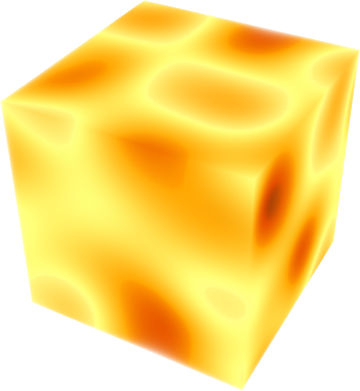
{MaxDetect[Image3D[u]], MinDetect[Image3D[u]]} // Row

Let us check the projection on a more rough 3D field
u1 = GaussianRandomField[n = 32*4, 3, Function[k, Exp[-1/15 k^2]]] // Chop;
pl1 = HighlightImage @@ {Plus @@ u1 // Image // ImageAdjust,
Plus @@ ImageData[MaxDetect[Image3D[u1]]] // Image}

We can also access directly the coordinates of the extrema
u = GaussianRandomField[n = 32, 3, Function[k, Exp[-k^2]]] // Chop;
MaxDetect[u] // SparseArray // ArrayRules
(*
{{1,1,2}->1,{1,1,20}->1,{1,1,32}->1,{1,12,32}->1,{1,23,4}->1,{1,27,32}->1,{1,30,20}->1,{19,11,1}->1,{19,11,32}->1,{20,32,13}->1,{22,32,1}->1,{22,32,30}->1,{27,27,32}->1,{29,22,3}->1,{,,_}->0}
*)
With the new functionality Watershed of mathematica 10.0.1
It is now possible to get directly the 1D manifold connecting saddle points together
as follows:
Now the corresponding watersheds obeys
ttp = WatershedComponents@Image3D[u] /. x_?NumberQ :> If[x == 0, 1, 0];
ImageAdjust@Image3D@tts

ttm = WatershedComponents@Image3D[-u] /. x_?NumberQ :> If[x == 0, 1, 0];
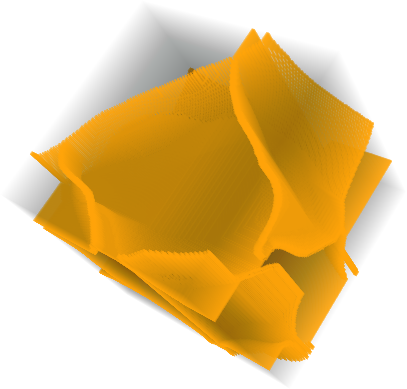
tts = ttp*ttm;
ImageAdjust@Image3D@tts
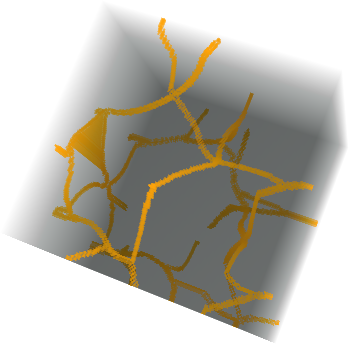
Following this great answer we can define a function to trace the skeleton as well
intersections[ws_] := Module[{unique, dims},
dims = Dimensions[ws];
Reap[
Do[
If[ws[[i, j, k]] == 0,
unique = (Flatten[
ws[[i - 1 ;; i + 1, j - 1 ;; j + 1, k - 1 ;; k + 1]]] //
Union)~Drop~1;
If[Length[unique] >= 3, Sow[{i, j, k, unique}]]
],
{i, 2, dims[[1]] - 1},
{j, 2, dims[[2]] - 1},
{k, 2, dims[[3]] - 1}
]
][[2, 1]]
]
Then the skeleton of a cube is simply given by
skl[cube_] := Module[{list = intersections[cube]},
SparseArray[#[[1 ;; 3]] -> 1 & /@ list] ]
So that
u = GaussianRandomField[n = 32*6, 3, Function[k, 1/k Exp[-1/2 k^2]]] //Chop;
dat = WatershedComponents@Image3D[u];
dat2 = WatershedComponents@Image3D[-u];
produces the set of critical lines connecting peaks and minima to saddles:
Row[Image3D[Normal[skl[#]]] & /@ {dat, dat2}] // Rasterize


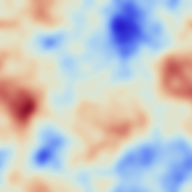



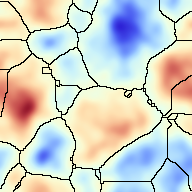


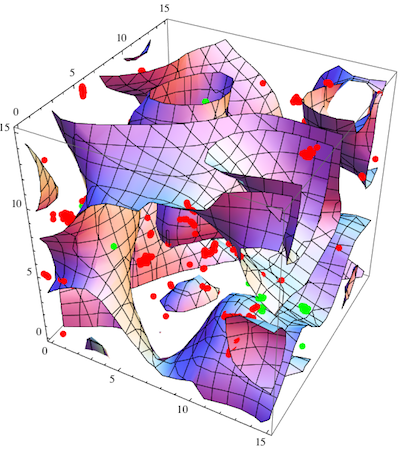



GaussianRandomFieldin the question (which was slow) or the improved addendum in your answer? I think you mean the latter, in which case you can link to it directly... $\endgroup$ListInterpolateyou introduced certain smoothness to your data which comes with the interpolation scheme. While you used this to get a function which you can derivate this maybe covers some critical points. Why don't you stay on your discrete data and check the huge amount of literature about extreme/sattle point finding algorithms? As an example maybe see this paper here. $\endgroup$